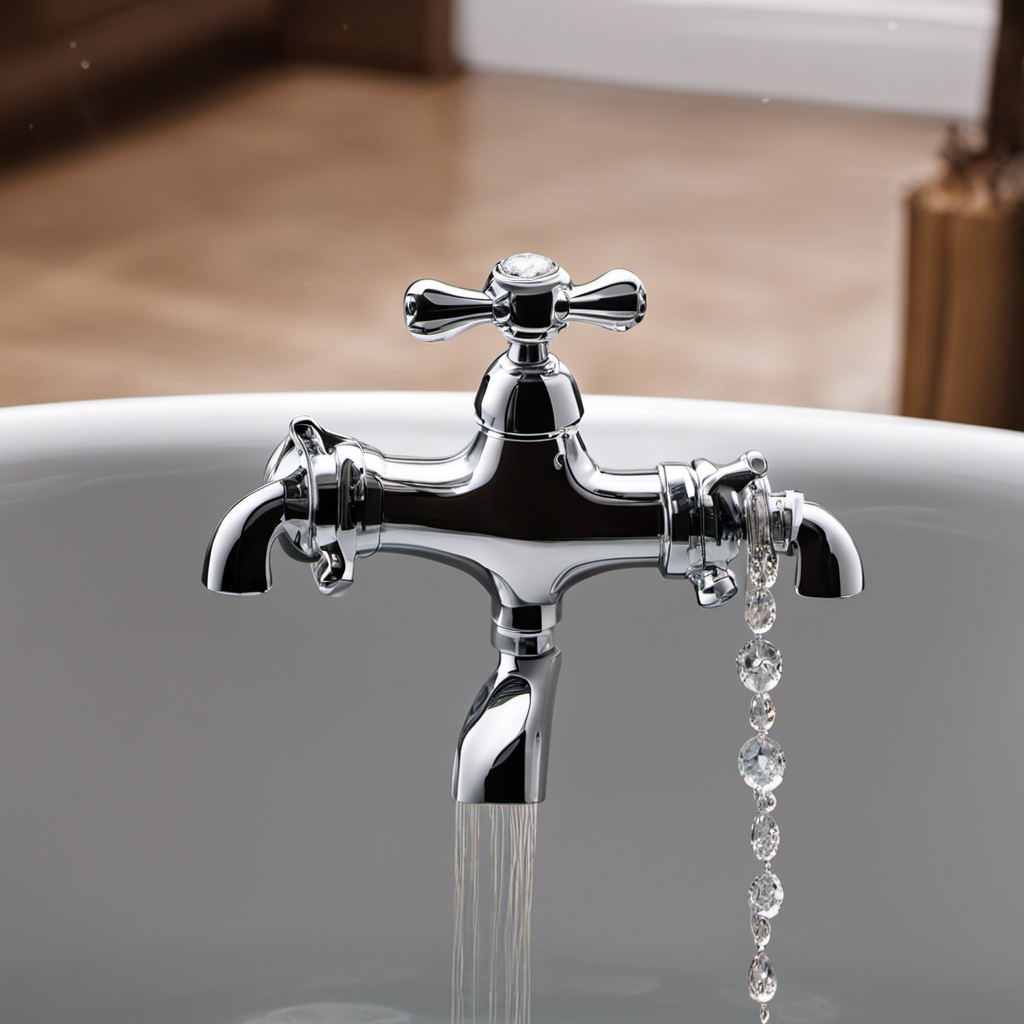So, you’ve discovered a pesky crack in your bathtub, huh? Well, fear not, because you’ve come to the right place! Fixing a cracked bathtub may seem like a daunting task, but with the right tools and a little know-how, you’ll have it looking good as new in no time.
In this article, we’ll guide you through the step-by-step process of assessing the crack, gathering the necessary tools and materials, preparing the bathtub surface, applying the repair solution, and finishing and sealing the repaired area.
Let’s dive in!
Key Takeaways
- Clean the crack with mild detergent and warm water
- Choose the right bathtub repair kit for your specific type of crack
- Thoroughly clean the cracks with mild cleaner and a soft sponge or brush
- Apply the repair solution evenly and smoothly over the cracked area
Assessing the Crack
First, you’ll want to carefully inspect the crack in your bathtub to determine the severity of the damage. Evaluating the damage is crucial in determining the best repair method to ensure a long-lasting fix.
Start by cleaning the crack with a mild detergent and warm water to remove any dirt or debris. Then, use a magnifying glass or flashlight to closely examine the crack. Look for any signs of depth, width, or length variations, as well as any surrounding damage or leaks.
This detailed evaluation will help you decide whether the crack can be repaired with a simple patch or if a more extensive repair is needed.
Once you have assessed the crack, you can move on to gathering the necessary tools and materials for the repair process.
Gathering the Necessary Tools and Materials
Next, you’ll want to gather all the tools and materials needed to repair the crack in your bathtub. Repairing a cracked bathtub can be a daunting task, but with the right tools and materials, you can restore it to its former glory.
Here are some key items to consider:
- A bathtub repair kit: Choosing the right repair kit is crucial, as different kits are designed for specific types of bathtubs and cracks.
- Safety equipment: Ensure you have protective gloves, goggles, and a respirator mask to protect yourself from any harmful chemicals.
- Sandpaper: You’ll need sandpaper to smooth out the surface of the crack before applying the repair material.
- Epoxy or fiberglass filler: These materials are commonly used to fill and reinforce bathtub cracks.
- Putty knife: To apply the repair material evenly and smoothly.
By exploring professional repair options and gathering the necessary tools and materials, you are taking the first steps towards fixing your cracked bathtub.
Once you have everything ready, you can move on to preparing the bathtub surface for repair.
Preparing the Bathtub Surface
Before starting the repair process, it’s important to properly prepare the surface of the bathtub for the upcoming repairs. Begin by prepping the surface to ensure a successful repair.
Start by thoroughly cleaning the cracks in the bathtub. Use a mild cleaner and a soft sponge or brush to remove any dirt, grime, or soap residue from the cracks. Make sure to rinse the surface thoroughly and allow it to dry completely before proceeding.
Next, inspect the cracks closely to determine their depth and width. If the cracks are larger than 1/8 inch, it may be necessary to widen them slightly using a rotary tool or a chisel. This will create a wider groove for the repair material to adhere to.
Once the cracks are clean and properly inspected, you can proceed with the repair process.
Applying the Repair Solution
Now that the cracks have been cleaned and inspected, it’s time to apply the repair solution. This step is crucial in fixing your cracked bathtub.
Here are some repair solution application techniques and common mistakes to avoid when applying the repair solution:
- Smooth Application: Ensure that the repair solution is applied evenly and smoothly over the cracked area.
- Adequate Coverage: Make sure to cover the entire crack with the repair solution, extending slightly beyond the damaged area.
- Proper Drying Time: Allow the repair solution to dry completely according to the manufacturer’s instructions before using the bathtub.
- Avoid Excessive Force: Do not apply excessive pressure or force on the repaired area, as it may cause further damage.
- Regular Maintenance: Perform regular inspections and maintenance to prevent future cracks from forming.
By following these techniques and avoiding common mistakes, you can effectively repair your cracked bathtub.
Once the repair solution has dried, you can move on to the next step of finishing and sealing the repaired area.
Finishing and Sealing the Repaired Area
Once the repair solution has dried, it’s important to finish and seal the repaired area to ensure long-lasting results. Sealing the repaired area is crucial for preventing further damage and maintaining the integrity of the bathtub.
There are several sealing techniques you can use to achieve this. One common mistake is using the wrong type of sealant. It’s important to choose a sealant specifically designed for use in bathrooms and on bathtubs. Another mistake is not properly preparing the surface before applying the sealant. Make sure to clean the area thoroughly and remove any remaining debris or residue. Additionally, ensure that the surface is completely dry before applying the sealant.
Frequently Asked Questions
Can I Still Use My Bathtub While It Has a Crack?
You shouldn’t use a bathtub with a crack due to potential dangers like water leakage, structural damage, and mold growth. Consider alternatives like using a temporary sealant or contacting a professional for repairs.
How Long Does It Take for the Repair Solution to Fully Cure?
To ensure proper curing of the repair solution, it is crucial to follow the recommended curing time. This ensures a strong and long-lasting repair. Additionally, taking preventative measures like avoiding excessive weight and using non-abrasive cleaners can help prevent future cracks in your bathtub.
Will the Repaired Area Be as Strong as the Original Surface?
The repaired area will be as strong as the original surface. The durability of the repair solution ensures that it bonds securely, providing a reliable and long-lasting fix for your cracked bathtub.
Can I Fix a Crack in a Fiberglass Bathtub Using the Same Repair Solution?
Yes, you can fix a crack in a fiberglass bathtub using the same repair solution. There are various bathtub crack repair methods available for fiberglass tubs that can effectively restore its strength and durability.
Is It Necessary to Hire a Professional to Fix a Cracked Bathtub, or Can It Be Done as a DIY Project?
You may consider DIY bathtub repair, but hiring professionals for bathtub repair is necessary if you want a reliable and long-lasting fix. They have the expertise and tools required for a proper repair.
Conclusion
So there you have it! Now that you know how to fix a cracked bathtub, you can save yourself the hassle and expense of replacing the entire tub.
By following the steps outlined in this guide, you’ll be able to assess the crack, gather the necessary tools and materials, prepare the bathtub surface, apply the repair solution, and finish and seal the repaired area.
With a little bit of time and effort, your bathtub will be as good as new. Don’t let a cracked tub cramp your style, fix it today!










